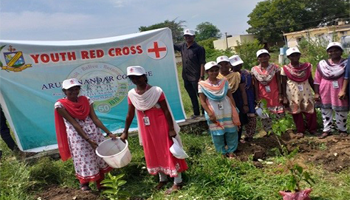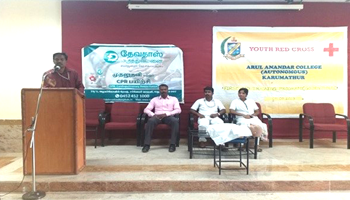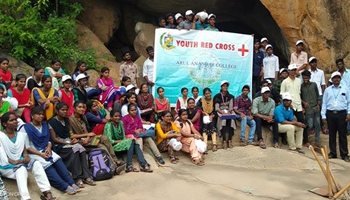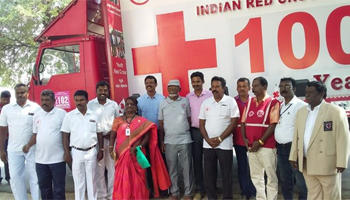- Home
- About us
- Administration
- Academics
- Research
- Student Support
- Outreach
- Alumni
- Admissions
- AAC Portal
- Contact

Youth Red Cross (YRC)
Young Swiss businessman, Jean Henry Dunant was appalled by the condition of the wounded soldiers he happened to see in the battle field of Solferino , Italy in 1859 during the Franco - Austrian war. He arranged relief services with the help of the local community immediately. He wrote the book 'Memory of Solferino' suggesting that a neutral organization be established to aid the wounded soldiers in times of war. Just a year after the release of this book, an international conference was convened in Geneva to consider the suggestions of Henry Dunant and thus the Red Cross Movement was born. International Red Cross Movement was established by Geneva Convention of 1864. The name and the emblem of the movement are derived from the reversal of the Swiss national flag, to honor the country in which Red Cross was found.
During the First World War in 1914, India had no organization for relief services to the affected soldiers, except a branch of the St. John Ambulance Association and by a Joint Committee of the British Red Cross. Later, a branch of the same Committee was started to undertake the much needed relief services in collaboration with the St. John Ambulance Association in aid of the soldiers as well as civilian sufferers of the horrors of that Great War. A bill to constitute the Indian Red Cross Society, Independent of the British Red Cross, was introduced in the Indian Legislative Council on 3rd March 1920 by Sir Claude Hill, member of the Viceroy's Executive Council who was also Chairman of the Joint war Committee in India. The Bill was passed on 17th March 1920 and became Act XV of 1920 with the assent of the Governor General on the 20th March 1920. On 7th June 1920, fifty members were formally nominated to constitute the Indian Red Cross Society and the first Managing Body was elected from among them with Sir Malcolm Hailey as Chairman. Indian Red Cross Society is a member of the International Federation of Red Cross and Red Crescent Movement. Relations between the IRCS and the India Delegation of the Federation are strong. Indian Red Cross Society has partnership with National Red Cross and Red Crescent Societies, St.John Ambulance, International Federation of Red Cross and Red Crescent Movement (IFRC), International Committee of the Red Cross (ICRC ), Multinational firms. Individuals and others in supporting IRCS activities. It also coordinates with Indian Government and other agencies ( UNDP, WHO etc ) The Indian Red Cross is a voluntary humanitarian organization having a network of over 1100 branches throughout the country, providing relief in times of disasters/emergencies and promotes health & care of the vulnerable people and communities. It is a leading member of the largest independent humanitarian organization in the world, the International Red Cross & Red Crescent Movement. The movement has three main components, the International Committee of Red Cross (ICRC), 192 National Societies and International Federation of Red Cross and Red Crescent Societies. Indian Red Cross Society (IRCS) was established in 1920 under the Indian Red Cross Society Act and incorporated under Parliament Act XV of 1920. The act was last amended in 1992 and of rules was formed in 1994.The IRCS has 36 State / Union Territories Branches with their more than 1100 districts and sub district branches. Honorable President of India is the President and Hon'ble Union Health Minister is the Chairman of the Society. The Vice Chairman is elected by the members of the Managing Body. The National Managing Body consists of 19 members. The Chairman and 6 members are nominated by the President. The remaining 12 are elected by the state and union territory branches through an electoral college. The Managing Body is responsible for governance and supervision of the functions of the society through a number of committees. The Secretary General is the Chief Executive of the Society. Red Cross on a white background is the Emblem of Red Cross, recognized in 1864 as the distinctive sign for medical relief teams on the battle field. In the Russo-Turkish war the Ottoman empire used a Red Crescent in place of the Red Cross. Egypt too opted for the Red Crescent while Persia chose a Red Lion on a white background. These symbols were written and accepted into the 1929 Geneva Conventions. The IRCS adopted RED CROSS as its emblem. The National Society make use of the emblem as an indicative device in peacetime and during armed conflicts within the limits stipulated in national legislation, the regulations and its statutes only for activities consistent with the principles set out by International Federation of the Red Cross and Red Crescent. During the General Assembly and the council of Delegates in November 2005 at Geneva, Red Crystal has been adopted as another emblem for the Red Cross Red Crescent movement. To enhance the understanding about the Red Cross Red Crescent Movement & its Fundamental Principles and promote peace and harmony among the youth and the selected communities. To strengthen the capacity of the YRC in the area of Hygiene Promotion, Household Water Treatment, Basic First Aid and Promoting Peace and harmony. To contribute towards increasing the awareness of and behavioral changes in the selected communities on Hygiene Promotion, Household Water Treatment and basic First Aid. "Youth Red Cross" is one of the wings of Indian Red Cross Society. It is a movement that organized at the college level. This is for students between 18 and 25 years of age. A qualified Lecturer is recognized as the leader. He is called the Programme Officer under whose guidance, the students are trained and encouraged to manage the affairs of the group, electing their own Office-Bearers. To impart value based education to students in order to face the global competition and to empower them to the new era of technology. The Mission of the Indian Red Cross is to inspire, encourage and initiate at all times all forms of humanitarian activities so that human suffering can be minimized and even prevented and thus contribute to creating more congenial climate for peace. To disseminate engineering education and To strengthen the highly effective and innovative technocratic women of our nation. Health Service Friendship
Orientation Programme to newly admitted students about YRC Grant Parents Day and Anti Liquor Signature Campaign First Aid & Fire Safety Training Old age Home Visit Geneva Convention Day Celebration of National Days |
|||||||||||||||||||||||||||||||||||||||||||||||||||||||||||||||||||||||
|
|||||||||||||||||||||||||||||||||||||||||||||||||||||||||||||||||||||||
|
|||||||||||||||||||||||||||||||||||||||||||||||||||||||||||||||||||||||
|
|||||||||||||||||||||||||||||||||||||||||||||||||||||||||||||||||||||||
|
|||||||||||||||||||||||||||||||||||||||||||||||||||||||||||||||||||||||
|
|||||||||||||||||||||||||||||||||||||||||||||||||||||||||||||||||||||||
|
|||||||||||||||||||||||||||||||||||||||||||||||||||||||||||||||||||||||
|
|||||||||||||||||||||||||||||||||||||||||||||||||||||||||||||||||||||||
|
|||||||||||||||||||||||||||||||||||||||||||||||||||||||||||||||||||||||
|
|||||||||||||||||||||||||||||||||||||||||||||||||||||||||||||||||||||||





